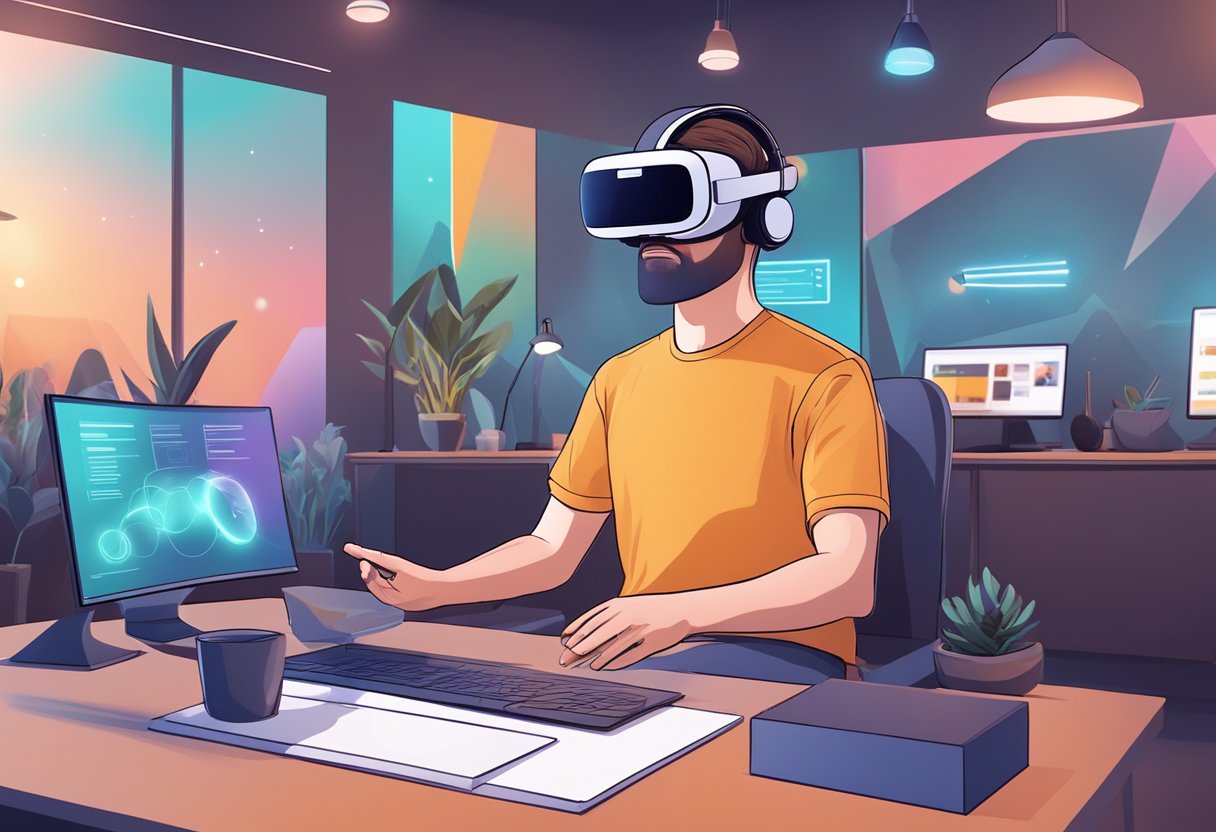The Metaverse, a term coined by science-fiction author Neal Stephenson, is a virtual world that is expected to be the next big thing in tech. It is a collective virtual shared space, created by the convergence of physical and virtual reality, where users can interact with a computer-generated environment and other users. Companies like Facebook, Google, and Microsoft are investing billions of dollars in the Metaverse, hoping to capitalize on its potential.
Understanding the Metaverse is essential to understand its costs. Building a Metaverse application requires significant investment in hardware, software, and infrastructure. The cost of developing a Metaverse application varies depending on the scale and complexity of the project. According to a Forbes report, Facebook expects the Metaverse project to cost at least $10 billion in 2021 alone. However, the cost of building a Metaverse application is not limited to the initial investment. There are also ongoing costs associated with maintaining and updating the application.
Key Takeaways
- The Metaverse is a shared virtual space where users can interact with a computer-generated environment and other users.
- It can cost anywhere between $30,000 to $300,000 to build a Metaverse application depending on the nature of the project.
- Building a Metaverse application requires a significant investment in hardware, software, and infrastructure, with ongoing costs associated with maintaining and updating the application.
- The cost of developing a Metaverse application varies depending on the scale and complexity of the project, with Facebook expecting the Metaverse project to cost at least $10 billion in 2021 alone.
Understanding the Metaverse

The Metaverse is a term coined by science fiction author Neal Stephenson in his novel Snow Crash. It refers to a collective virtual shared space that is created by the convergence of multiple virtual worlds, augmented reality, and the internet. It is a digital world where users can interact with each other and their surroundings in a virtual environment.
The Metaverse is not limited to virtual reality (VR) or augmented reality (AR) but is a combination of both. VR is a computer-generated simulation of a three-dimensional environment, while AR is an overlay of digital information on the real world. In the Metaverse, users can experience both VR and AR simultaneously.
The Metaverse is considered the future of the internet, where users can create and interact with digital content in a shared space. It is a new form of social media, where users can interact with each other in a virtual environment. The Metaverse is expected to revolutionize the way we interact with the digital world.
Creating the Metaverse involves a complex process that requires a significant investment of time and money. According to a recent report by Precedence Research, the Metaverse market was valued at $40 billion in 2022 and is projected to reach an estimated $1,607.12 billion by 2030. This indicates a significant Compound Annual Growth Rate (CAGR) of 50.74% from 2022 to 2030. The global Metaverse market reached a value of USD 68.49 billion in 2022 and is projected to exceed USD 1.3 trillion by 2030, with a remarkable CAGR of 44.5% during the forecast period from 2022 to 2030.
In conclusion, the Metaverse is a digital world that is expected to revolutionize the way we interact with the internet. It is a combination of virtual reality, augmented reality, and the internet, where users can create and interact with digital content in a shared space. Creating the Metaverse involves a significant investment of time and money, but it is projected to be a lucrative market in the future.
Average cost to build a metaverse application

Building a metaverse application can be a costly endeavor, and the cost can vary depending on the scope of the project. The average cost to develop a metaverse application can range from $25 to $150 per hour, depending on the development firm and the complexity of the project. Some firms may charge even higher rates for more complex projects.
To give an idea of the cost, a 1×1 area in the metaverse can cost around $30,000 if landowners opt to create a customized experience rather than using the native building tools and stock content available on each platform. To trade in the metaverse, virtual currency or tokens are required, which facilitate digital transactions using blockchain technology.
According to a recent report by Precedence Research, the metaverse market was valued at $40 billion in 2022 and is projected to reach an estimated $1,607.12 billion by 2030. This indicates a significant Compound Annual Growth Rate (CAGR) of 50.74% from 2022 to 2030. Facebook has invested around $10 billion in the metaverse, which is a clear indication of the potential of this emerging technology.
In addition to development costs, there are ongoing costs associated with maintaining and updating a metaverse application. These costs can include server costs, hosting fees, and ongoing development costs to keep the application up-to-date with the latest technologies and features.
Overall, building a metaverse application can be a significant investment, but with the potential for significant returns and growth in the coming years, it can be a worthwhile investment for companies and developers looking to enter the metaverse market.
Cost Factors of the Metaverse

The metaverse is a virtual world that is being developed by tech companies such as Facebook, Google, Microsoft, and Apple. The cost of developing the metaverse is influenced by several factors, including investment and expenses, revenue and profitability, and the involvement of tech giants in the metaverse.
Investment and Expenses
The development of the metaverse requires a significant investment in research and development, hardware, and software. Meta, the parent company of Facebook, has spent $36 billion on the metaverse as of 2022, resulting in an operating loss of $5.6 billion. This investment includes the development of VR headsets such as the Oculus Quest headset.
Revenue and Profitability
The metaverse has the potential to generate significant revenue through advertising, virtual goods, and other business models. However, it is not yet clear how profitable the metaverse will be for businesses and investors. According to an analysis by Plan B, the metaverse market is projected to reach $1.3 trillion by 2030, with a CAGR of 44.5% during the forecast period from 2022 to 2030. This indicates significant growth potential for the metaverse.
Tech Giants in the Metaverse
Several tech giants such as Facebook, Google, Microsoft, and Apple are investing heavily in the metaverse. Meta CEO Mark Zuckerberg has stated that the metaverse is the next generation of the internet, and it is expected to be a major focus for the company in the coming years. Google has also been investing in the metaverse through its Google Reality Labs, which is focused on developing VR and AR technologies. Microsoft is developing its own metaverse platform, called Mesh, which will allow users to collaborate in virtual environments.
In conclusion, the cost of developing the metaverse is influenced by several factors, including investment and expenses, revenue and profitability, and the involvement of tech giants in the metaverse. While the metaverse has significant growth potential, it remains to be seen how profitable it will be for businesses and investors.
The Metaverse User Experience

The Metaverse is essentially a 3D version of the internet that is gaining popularity among users. To break into the mainstream and become popular with the public, metaverse platforms should focus on user experience and minimizing entry barriers to increase uptake. This section will explore the social and gaming aspects, as well as the hardware and technology involved in the Metaverse user experience.
Social and Gaming Aspects
Users can interact and engage with others in the Metaverse, creating a social experience that is similar to social media platforms. The Metaverse also offers gaming aspects, allowing users to play games with others in a virtual environment. Fortnite is one of the most popular games in the Metaverse, and it has been successful in attracting users to the platform. Horizon Worlds is another Metaverse platform that offers gaming experiences.
Andrew Bosworth, Facebook’s head of reality labs, stated in a conference call that the social aspect of the Metaverse is just as important as the gaming aspect. He believes that the Metaverse will be a place where people can connect with others and build meaningful relationships.
Hardware and Technology
The Metaverse requires VR technology to create the immersive experience that users expect. Oculus is the leading provider of VR headsets, and the Quest headset is the most popular for use in the Metaverse. However, the headsets can be costly, with the Quest 2 priced at $299.
To participate in the Metaverse, users need a VR headset, a computer or mobile device, and a stable internet connection. The cost of entry can be a barrier for some users, but as the technology becomes more accessible, the cost is likely to decrease.
In conclusion, the Metaverse offers a unique user experience that combines social and gaming aspects in a virtual environment. The hardware and technology involved can be costly, but as the technology becomes more accessible, the cost is likely to decrease. Metaverse platforms should focus on user experience and minimizing entry barriers to increase uptake.
Bottom Line

Creating a metaverse is a complex and expensive process. The cost of building a metaverse can vary widely depending on various factors such as the size of the project, the level of detail, and the features included. According to a recent report by Precedence Research, the metaverse market was valued at $40 billion, and it is projected to reach an estimated $1,607.12 billion by 2030. This indicates a significant Compound Annual Growth Rate (CAGR) of 50.74% from 2022 to 2030.
The cost of building a metaverse depends on many factors, such as the size of the project, the level of detail, and the features included. For example, building a virtual world with basic graphics and no interactive features would cost significantly less than building a fully immersive, interactive metaverse with advanced graphics and features.
One of the main costs associated with building a metaverse is the development of the software, which includes the creation of the virtual world, the user interface, and the various features. Other costs include the hardware required to run the metaverse, such as servers, storage, and networking equipment. Additionally, marketing and advertising costs can add up quickly, especially for new metaverses that are trying to attract users.
Overall, building a metaverse is a costly undertaking, but the potential rewards can be significant. As the technology continues to evolve and become more advanced, the cost of building a metaverse is likely to decrease. However, for now, it remains a significant investment that requires careful planning, research, and execution.




